|
|
|
|
|
|
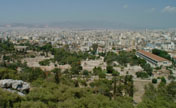 The
Ancient Agora as seen from the Areopagus, a small rocky hill adjacent to the
Acropolis. The
Ancient Agora as seen from the Areopagus, a small rocky hill adjacent to the
Acropolis.
|
|
 The
Ancient Agora as seen from the Acropolis. The
Ancient Agora as seen from the Acropolis.
|
|
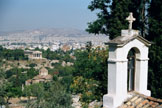 The
Temple of Hephaestus and Athena as seen from a church on a
nearby hill. Since part of the sculptural decorations depict the exploits of
Theseus, the temple has also become known as the Theseion. The
Temple of Hephaestus and Athena as seen from a church on a
nearby hill. Since part of the sculptural decorations depict the exploits of
Theseus, the temple has also become known as the Theseion. |
|
|
|
|
|
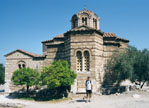 The
only standing Byzantine monument in the Agora is the Church of the Holy
Apostles (XI century). The
only standing Byzantine monument in the Agora is the Church of the Holy
Apostles (XI century). |
|
 View
of the the Ancient Agora with the Theseion to the left and the Odeion of
Agrippa towards the right. View
of the the Ancient Agora with the Theseion to the left and the Odeion of
Agrippa towards the right. |
|
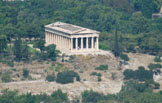 The
Theseion as seen from the Acropolis. The Pentelic marble temple was built
from 449-440
BCE. The
Theseion as seen from the Acropolis. The Pentelic marble temple was built
from 449-440
BCE. |
|
|
|
|
|
 The
Temple of Hephaestus from the east. The temple, standing on the
Colonus Agoraeus hill, dominates the site of the ancient Agora. The
Temple of Hephaestus from the east. The temple, standing on the
Colonus Agoraeus hill, dominates the site of the ancient Agora. |
|
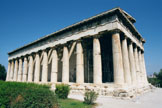 The
Theseion was dedicated to two gods, Hephaestus and Athena Ergane,
whose bronze cult statues stood in the interior. Both divinities were worshipped as patrons of the arts and
trades. The
Theseion was dedicated to two gods, Hephaestus and Athena Ergane,
whose bronze cult statues stood in the interior. Both divinities were worshipped as patrons of the arts and
trades. |
|
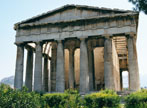 The
southern side of the temple. The Theseion is Doric, peripteral, with a pronaos and opisthodomos. It is the most prominent and
best preserved monument of the Agora. The
southern side of the temple. The Theseion is Doric, peripteral, with a pronaos and opisthodomos. It is the most prominent and
best preserved monument of the Agora. |
|
|
|
|
|
 Detail
of the Theseion's sculptures. Detail
of the Theseion's sculptures. |
|
 Detail
of the Theseion's sculptures. Detail
of the Theseion's sculptures. |
|
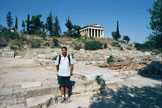 The
Theseion in the background and the remains of the Bouleuterion and Metroon
in the foreground. The
Theseion in the background and the remains of the Bouleuterion and Metroon
in the foreground. |
|
|
|
|
|
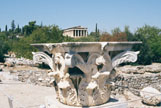 A
Corinthian column with the Theseion in the background. A
Corinthian column with the Theseion in the background. |
|
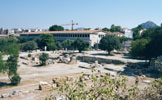 The
eastern side of the Agora is bounded by the restored Stoa of Attalus II
(2nd century BCE). The
eastern side of the Agora is bounded by the restored Stoa of Attalus II
(2nd century BCE). |
|
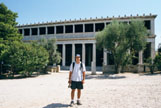 The Stoa of Attalus II, now used as a
museum, was completely rebuilt in 1953-56 on its original 2nd century
foundations using ancient materials. The Stoa of Attalus II, now used as a
museum, was completely rebuilt in 1953-56 on its original 2nd century
foundations using ancient materials. |
|
|
|
|
|
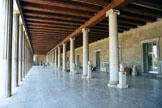 View
of the colonnade inside the
Stoa of Attalus II. View
of the colonnade inside the
Stoa of Attalus II. |
|
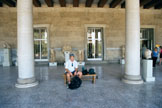 Originally
a trading center and place for leisure, the stoa had a series of shops
which the state rented to private merchants. Originally
a trading center and place for leisure, the stoa had a series of shops
which the state rented to private merchants. |
|
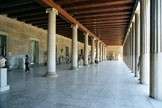 The
Stoa of Attalus II had two stories, supported on columns which were all
Ionic except for those on the outer side of the ground floor which were
Doric. The
Stoa of Attalus II had two stories, supported on columns which were all
Ionic except for those on the outer side of the ground floor which were
Doric. |
|
|
|
|
|
 Flying
Victory. Acroterium from the southeast corner of the stoa of Zeus.
Circa 400 BCE. Flying
Victory. Acroterium from the southeast corner of the stoa of Zeus.
Circa 400 BCE. |
|
 Statue
of Pan. Statue
of Pan. |
|
 The
statue of Hadrian. Hadrian was Emperor of Rome from 117-138 CE. The statue
dates from the 2nd century CE. The
statue of Hadrian. Hadrian was Emperor of Rome from 117-138 CE. The statue
dates from the 2nd century CE. |
|
|
|
|
|
 The
Odeion of Agrippa was built in 15 BCE and comprised an
auditorium with a seating capacity of about 1000 people and a two-story
portico. The
Odeion of Agrippa was built in 15 BCE and comprised an
auditorium with a seating capacity of about 1000 people and a two-story
portico. |
|
 The
Odeion of Agrippa. Its north side is adorned by three (of the original
four) colossal figures of Giants and Tritons set up on massive pedestals.
These were added to the Odeion after 150 CE. The
Odeion of Agrippa. Its north side is adorned by three (of the original
four) colossal figures of Giants and Tritons set up on massive pedestals.
These were added to the Odeion after 150 CE. |
|
 A
colossal figure of a Triton (half god, half fish) once adorned the facade
of the Odeion of Agrippa. A
colossal figure of a Triton (half god, half fish) once adorned the facade
of the Odeion of Agrippa. |
|
|
|
|
|